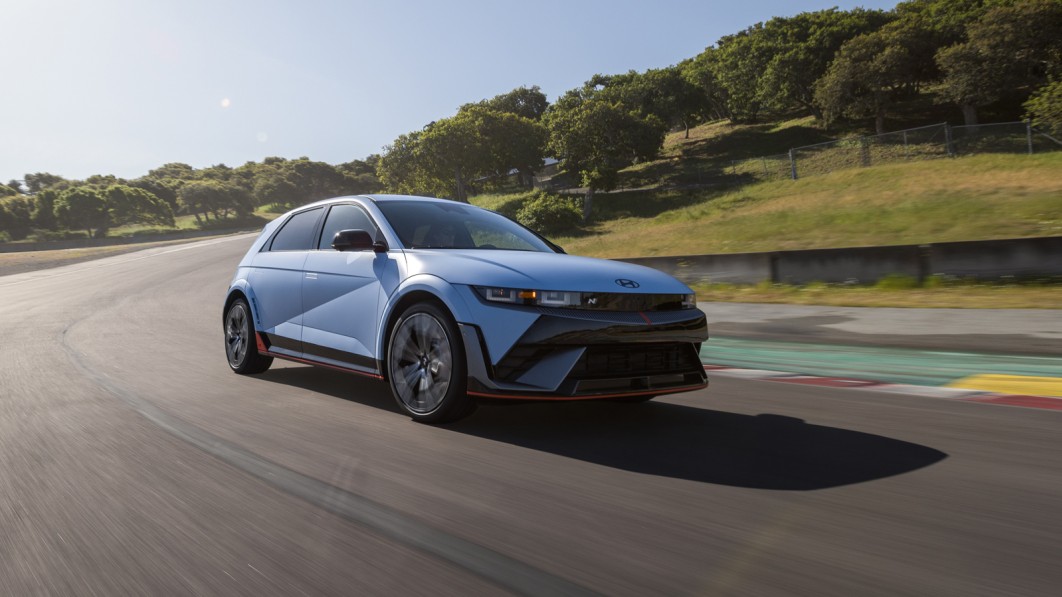SALINAS, Calif. – For people who love to drive – beyond a straight-and-narrow stoplight blast – EVs present a conundrum. They’re swift, seamless and squeaky-clean. But they tend to be isolating, shy on character and driver engagement. Early exceptions to the rule, your Porsche Taycans or Lucid Airs, are beyond the reach of many buyers.
The 2025 Hyundai Ioniq 5 N seeks to change all that, heightening sensation, sound, rally-car moves and even DIY gear changes. History’s most powerful Hyundai is 641 horses worth of newfangled tech that aims to feel old and familiar. And it mostly succeeds, as I discovered while chasing 11-time Pikes Peak Hill Climb winner Paul Dallenbach around Laguna Seca. To burnish the racing bona fides, Dallenbach will drive a showroom-spec Ioniq 5 N up Pikes Peak’s 156 turns in hopes of setting a record time for production electric SUVs, a feat the team believes is well within reach.
Dallenbach’s quiet confidence bodes well for the N division’s first EV, a lavishly upgraded Ioniq 5 that starts from $67,475 in near-loaded guise. A sweet $1,000 coat of Performance Blue Matte paint and floormats kicked that to $68,675. For comparison’s sake, Porsche’s 630-hp electric Macan Turbo starts at $106,950 before the first option is rung up. Even the 402-hp Macan 4 will start from $80,450, and give up 239 horsepower to Hyundai’s latest overachiever.

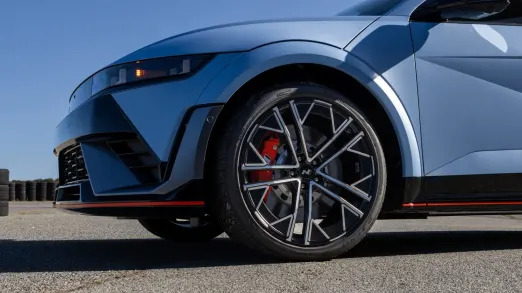
We amateurs feel good about our own chances, as we spur Hyundai’s little “Corner Rascal” through Laguna Seca’s stomach-flipping elevations and 11 curves. OK, not so “little,” considering its chunky 4,861-pound curb weight. But the Hyundai is no poseur, down to a revised-chemistry battery that squeezes 84 usable kilowatt hours from the same-size pack as the Ioniq 5 with 77.4 kWh. Aerodynamics, radiators and (electric) motor oil cooling are all upgraded to track spec – plus, it adds a unique battery chiller to the equation.
As with every N division model, including the Elantra N, the fingerprints of Hyundai’s retired uber-engineer (and former BMW M division chief) Albert Biermann are all over this baby. They show in the car’s delightfully frisky, balanced handling. I force a few easy-peasy slides on bespoke 21-inch Pirelli P Zero “Elect” series tires. The car is clearly heavy relative to its footprint, but a 641-hp boot balances that equation, as does expert tuning and a low center of gravity. A Drift mode can even simulate the clutch kick of a manual car to initiate rotation.
Versus a standard Ioniq 5 or even Kia EV6 GT, the chassis is 10% stiffer with 42 more welding points and 6.9 feet of added structural adhesives. A longer, lower body drops ground clearance and the driver’s seat by nearly an inch; and grows 2 inches wider to fit handsome 21-inch forged wheels. A driver’s hip point drops by 1.6 inches in snugly bolstered, microsuede-covered sport seats; a welcome edge in any tippy-toes crossover. There are retuned springs, bushings and three-position electronic dampers, alongside lighter aluminum lower control arms.
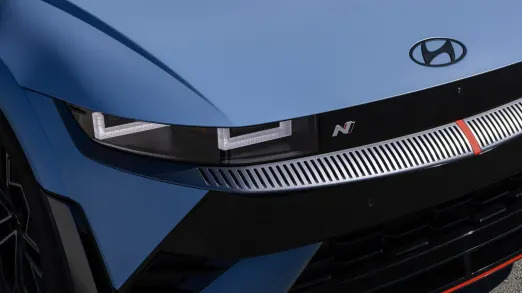
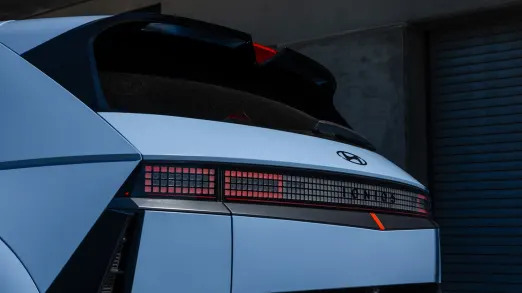
Some fans might prefer stealth, but the Ioniq 5 N wears its racy heart on orange-embroidered sleeves. An enlarged front grille and a new nosepiece integrate active air flaps and curtains, with black side mirrors and aluminum N badges. A lengthened roof spoiler and rear diffuser pair with checkered-flag-inspired rear lighting. A “Luminous Orange” strip wraps the lower body. Inside, a fixed, full-length center console replaces the open floor plan of a standard Ioniq 5 for a more cockpit-like feel.
Before pulling out onto pit lane, I dial up battery preconditioning and an N Race setting that manages battery output for all-out Sprint or Endurance runs. Hyundai says the 800-volt architecture matches the speediest charge of a standard Ioniq 5, so this Hyundai is designed to romp on circuits for about 20 minutes, recharge to 80% in about 18 minutes – assuming a 350-kilowatt DC fast charger is nearby – and head back out to embarrass your buds at track days. N engineers put in more than 6,200 Nürburgring miles to develop an EV that can run two Nordschliefe laps back-to-back. Many EVs can barely manage one before they’re spent or overheated.
Peeling onto Laguna’s front straightaway, I mash the orange “NGB” button on the N’s chunky steering wheel. Its clunky “N Grin Boost” name appears spitballed from a soju-fueled marketing meeting in Seoul. But the welcome effect is a 40-horsepower boost (from 601 to 641) in 10-second squirts. Torque rises from 545 pound-feet to 568, the latter topping a Model Y Performance by 71 pound-feet. Summoning launch control elicits a 0-60 mph scalding in a claimed 3.25 seconds. Top speed is a healthy 162 mph.
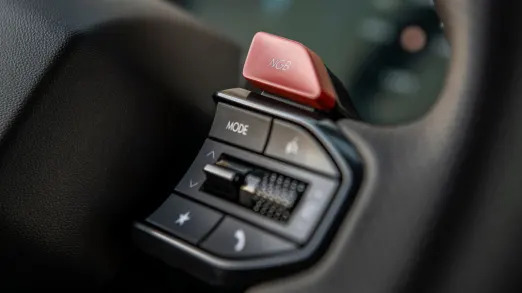

Barnstorming laps are accompanied by a trio of selectable powertrain sounds, played through 10 internal and two external speakers. The most natural “Ignition mode” honks to the tune of the N division’s 2.0-liter four-cylinder engine found in the Elantra N. “Supersonic,” inspired by twin-engine fighter jets, adds a faux sonic boom tied to acceleration and cornering forces.
Most ingeniously, Hyundai engineers weren’t content with a same-old, single-speed EV transmission experience. Their paddle-shifted “N e-Shift” simulates the feel and engine revs of an eight-speed, dual-clutch gearbox. There’s even a tachometer on the 12.3-inch driver’s cluster, whose needle quivers at “idle” and zips toward 8,000 rpm, synced to the torque curve of a four-cylinder engine. (Pay no mind to the electric Oz behind the curtain, with dual motors that actually spin to 21,000 rpm). Drivers will feel surprisingly natural torque interruption, re-engagement and rev-matched downshifts. Moves are almost spookily matched to rising-and-falling engine sound, including selectable pops and burbles during shifts. When I bumped into the “redline” in manual mode, I paid the old-school price, as the Hyundai banged against a simulated rev limiter. Select too high a gear, and the powertrain lugs. Expect other performance automakers to adopt some version of this system, quickly.
Grouchy members of the Unleaded Forever Club may scoff at Hyundai’s bids for a more analog EV driving experience, especially those that involve simulation. But they’re not the ticket-paying audience for this car. And give Hyundai credit for its spirit of experimentation.
Hyundai claims an industry high for regenerative braking force with up to 0.6 g’s of deceleration. That saves overheating and wear and tear on mechanical brakes. The brake pedal then segues into the brand’s beefiest stoppers yet, including four-piston front calipers with 15.8-inch rotors. There’s Hyundai’s usual “i-Pedal” setting for maximum regen and one-pedal driving, and a Sport setting for faster response. The pedal itself is firm and trusty by EV standards, but still not as sensitive on track as top ICE models. In a nod to committed left-foot brakers, the Hyundai allows a simultaneous two-step on the brake pedal and accelerator without cutting power.

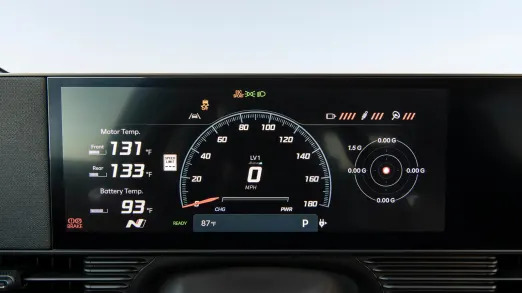
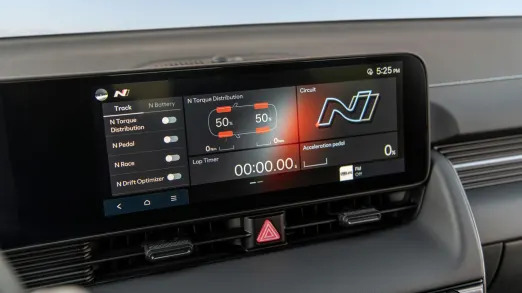
The Ioniq 5 N’s biggest misstep is a profusion of on-screen performance settings, enough to make a Mercedes or BMW seem a model of restraint. There are selections for motors, steering, brakes, stability control, shifting, sounds, battery management and more. Submenus have submenus: An overstuffed performance screen requires another screen layer for “performance options.” Launch control offers choices for high-, medium- or low-traction pavement when all you want is to smoke the guy at the stoplight. I asked Hyundai reps and engineers for help adjusting the electronic limited-slip differential, which can send 100% of power rearward. Five minutes later, they were still fussing with it, locked out by confusing preconditions for operation. Fortunately, a pair of N buttons on the steering wheel can store macro settings of preset configurations you use frequently.
Heading away from the track, I manage a fast-paced hour on everyday roads, including the dizzying Laureles Grade, among the myriad dream roads in Monterey County. Rack-mounted electric steering gets a faster ratio and pleasing (adjustable) heft. Feedback from the road remains a bit aloof but better than most EVs. A sharp-handling Mercedes-AMG GLB 35 I drove the previous day, over the same road, delivered trustier steering feel. But results are results, and the Hyundai would have made mincemeat of the same-size, 302-hp Benz, with more than double the horsepower and torque, and equal-or-better tire grip.
The other real-world bummer is a stingy 221-mile driving range, versus 260 miles for the regular AWD Ioniq 5, and up to 303 miles for single-motor versions. But that’s the price you pay for a Hyundai that sacrifices efficiency in service of glorious speed and genuine track capability. For buyers who will routinely put Mustangs, BMWs and even some Porsches in their rear-view mirrors, that’s no sacrifice at all.

